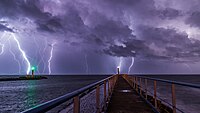
Photo from wikipedia
Natural cloud-to-ground (CG) lightning behaves differently over land and ocean. These differences likely reflect local variations in the speed at which storms develop over ocean, and are possibly contributed to… Click to show full abstract
Natural cloud-to-ground (CG) lightning behaves differently over land and ocean. These differences likely reflect local variations in the speed at which storms develop over ocean, and are possibly contributed to by differences in the local aerosol composition. Earlier studies have reported statistically larger peak currents for negative CG first strokes over ocean than over land. This work focuses on differences in this relationship for first strokes, for subsequent strokes in existing channels to ground, and for subsequent strokes creating new ground contacts. This distinction will shed light on the mechanism responsible for the observed land:ocean differences, and can either support or refute the hypothesis that this difference is associated with the propagation of downward negative leaders in free space, driven by the vertical profile of electric field within and below the cloud. Results show that when compensated for detection threshold increases with increasing distance from land-based sensors, the distribution of estimated peak currents for subsequent strokes in existing (pre-ionized) channels to ground was indistinguishable from distributions for lightning that occurred inland, near shore, offshore, and in the distant ocean (~200 km offshore), with median values ranging between 14.4 and 15.1 kA. Conversely, the population of first strokes over distant ocean had much higher peak currents than those that occurred inland (median values of 23.1 kA vs. 17.3 kA, respectively), when corrected for detection threshold. These findings are consistent with the field-profile hypothesis noted above since peak currents for return strokes due to downward leaders that establish new channels (first strokes) would be impacted the most by the vertical profile of electric field near the cloud base, whereas the peak current for strokes in previously-established channels should be far less dependent on the field profile.
Journal Title: IEEE Access
Year Published: 2019
Link to full text (if available)
Share on Social Media: Sign Up to like & get
recommendations!